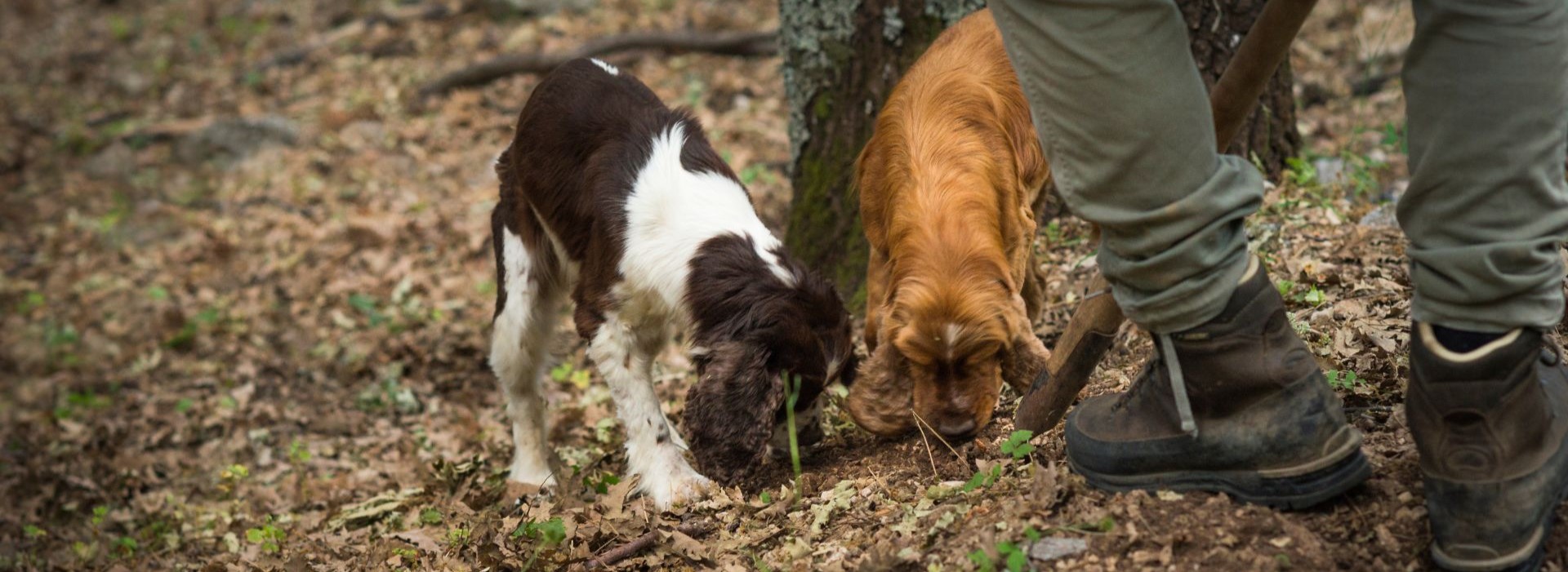Here’s a small guide for aspiring researchers of underground delicacies.
As we have seen in the previous articles,the truffles are underground “hypogeum fungus” that are extremely valuable and sought after. They naturally form in the soil at depths ranging from a few centimeters to, in exceptional cases, 60-100 cm.
If you are lovers of the typical taste and aroma of truffles and are interested to know about the world of truffle hunters but don’t know where to start, you’re in the right place! In this article, we’ll guide you through the fundamental steps to become a truffle hunter, providing practical advice to help you to approach this ancient art.
This fascinating profession offers the opportunity to immerse yourself in nature in the company of friendly truffle-hunting dogs and enjoy the thrill of treasure hunting.
1. The first step is to gather information to know the truffle:
Before starting on this career, it’s essential to acquire in-depth knowledge about the different types of truffles, their characteristics, and the places where they can be found. Study the most common varieties such as white truffle and black truffle, learn how to recognize them, and understand their seasonal availability. This will allow you to identify the best search areas.
2. amiliarize yourself with various species of truffle-bearing trees:
Truffles grow in symbiosis with certain species of trees, such as oaks, hazelnuts, or poplars, near their roots. Therefore, it’s crucial to know which trees to look for in order to increase the chances of success.

3. Training Truffle Dogs:
One of the most effective methods for locating truffles is with the help of dogs. Therefore, don’t neglect their training; it’s crucial that they are focused only on truffle hunting without being distracted by other smells. Trained dogs are capable of following the smell of truffles and indicating the exact location, greatly simplifying the task.
You will need to learn how to select and train them yourself or find an experienced dog trainer and participate in specific courses.

4. Identifying the Best Search Areas:
Truffles grow in various habitats, so it is important to know the geographical areas where they are most likely to be found. Factors such as soil conditions, altitude, climate, and the presence of truffle-bearing trees are crucial and shouldn’t be overlooked when choosing search areas.
Let’s take the example of white truffles as a starting point. The best habitats for them are invasion forests or areas that were previously cultivated and then abandoned: to promote their development, the soil should be loamy, relatively fertile, and have a balanced mixture of clay and sand. On the other hand, black truffles adapt to different areas as long as they are rich in calcium and prefer poor soil. As for the Summer truffle, also known as Scorzone or black truffle, it doesn’t thrive in dense and shady forests, but It tends to grow well near isolated trees or along watercourses.

5. Knowing the Harvesting Seasons:
It’s important to note that harvesting seasons may vary slightly depending on climatic conditions and yearly variations.
In Italy, the harvesting periods for truffles can vary depending on the region and the type of truffle. The most common ones are as follows:
- Pregiato Black Truffle (Tuber melanosporum): The harvesting season is from November to March, with the peak of maturity usually in December and January.
- Summer Truffle (Tuber aestivum): The harvesting season is from June to September, with the peak of maturity usually in July and August.
- Pregiato White Truffle (Tuber magnatum): The harvesting season is from September to December, with the peak of maturity usually in October and November… to learn more, click here!!
Harvesting Periods in Spain and France:
In Spain, as well as in France, the harvesting periods for truffles can vary depending on the region and the type of truffle. However, generally, the most common harvesting periods are as follows:
- Black Truffle (Tuber melanosporum): The harvesting season is from November to March, with the peak of maturity usually in December and January.
- Summer Truffle (Tuber aestivum): The harvesting season is from June to September, with the peak of maturity usually in July and August.

6. Tools and Digging Techniques:
To search for truffles, you will need the right tools. A truffle digging tool, better known as “ ruscella “ here, and a basket to collect your valuable findings… and the rest will come naturally!
This is the typical ruscella that is used here with us:

7. Licenses
The licensing requirements for truffle harvesting vary depending on the country, but whether you are in Italy, France, or Spain, a permit is always required for truffle hunting.
Italy
As a final step, you will need a license: we are referring to the Regional Concession Tax for conducting truffle research and harvesting, which must be paid by January 31st each year.
This eligibility card, issued by the applicant’s municipality of residence or the delegated U.O.D., is valid throughout the national territory. The exam consists of closed questions and an oral examination, typically lasting 30 minutes, with 30 closed-ended questions: the candidate must answer at least 26 questions correctly. But there is no need to worry because, to facilitate passing the exam, the Regional Territorial Offices, park management authorities, and mountain communities often organize preparatory courses!
park management authorities, and mountain communities often organize preparatory courses!
Spain
Yes, even in Spain, a license or authorization is required for truffle harvesting, which is regulated and controlled by local and regional authorities.
Specific regulations may vary from region to region, but in general, authorization or permission for truffle harvesting is required. These measures have been introduced to preserve its sustainability and ensure that harvesting takes place in a controlled and responsible manner.
To obtain authorization, it is often necessary to meet specific requirements and follow established procedures. This may include participating in training courses on truffle harvesting, adhering to specified harvesting seasons, and complying with quantity limits.
Furthermore, some regions may require owning a trained truffle-hunting dog, as using dogs is considered a traditional and sustainable method for locating truffles in the soil. It is strongly recommended to consult the competent local or regional authorities for precise information on specific regulations and procedures for truffle harvesting in the desired region.
Each Spanish region has its own regulations and competent body responsible for managing truffle harvesting. For example, in Aragon, the competent body is the Aragonese Institute for Agri-Food Development (IAF), while in Castilla-La Mancha, it is the Management Body for the Guarantee Mark of the Quality Product “Tuber melanosporum”.
France
A license or authorization is required for truffle harvesting in France. Truffle harvesting is regulated and controlled to ensure the sustainability and preservation of truffle varieties in the country.
Regulations for truffle harvesting in France may vary slightly from region to region, as the management of natural resources is primarily the responsibility of local authorities. However, there are some general guidelines that are common throughout the country.
To engage in truffle harvesting, it is usually necessary to obtain a license or authorization from the competent authorities, such as the municipality or prefecture of the region. Authorization requests may require information such as the applicant’s personal data, the intended harvesting area, and estimated quantities.
In France, the authorization and regulation of truffle harvesting are primarily managed by two organizations:
- Fédération Française des Trufficulteurs (FFT): The Fédération Française des Trufficulteurs is the main organization representing French truffle hunters. It provides information on regulations and practices related to truffle cultivation and harvesting. It collaborates with local authorities to promote sustainable truffle management.
- Office National des Forêts (ONF): The Office National des Forêts is the government agency responsible for the management of public forests in France. In some regions, such as Périgord, the ONF collaborates with the FFT and local authorities to regulate truffle harvesting in forest areas.
We would like to remind you once again that it is important to consider that regulations and procedures may vary slightly from region to region. Therefore, we recommend consulting the local authorities or specific truffle hunter associations in the region where you intend to harvest truffles to learn about specific rules and obtain the necessary authorizations..

Now that you have all the necessary information, we wish you a successful truffle hunting experience!
